
A new study claims to have found the first evidence that the soft drink sugar levy has been partially successful in tackling obesity.
The introduction of the tax in 2018 was associated with an 8% reduction in obesity among 10 and 11-year-old girls, according to researchers at Cambridge University.
Their research covered data for more than one million children in state-maintained English primary schools.
Students aged four to five and 10 to 11 were followed from September 2013 to November 2019. The researchers compared the obesity levels in the 19 months following the Soft Drinks Industry Levy (SDIL) with predicted obesity levels had it not been enacted.
In 10 and 11-year-old girls, there was an absolute reduction in the obesity rate of 1.6 percentage points, which equated to an 8% relative reduction in obesity rates.
The study found the greatest reductions were seen in girls in the most deprived areas with h an absolute reduction of 2.4 percentage points (in obesity prevalence.
In 10 and 11-year-old boys, the study found no overall change in obesity rates,
The study was published in this week’s edition of PLOS Medicine by Dr Nina Rogers of the University of Cambridge School of Clinical Medicine, UK, and her colleagues.
“Our findings suggest that the UK SDIL led to positive health impacts in the form of reduced obesity levels in girls aged 10-11 years,” the authors said. “Further strategies are needed to reduce obesity prevalence in primary school children overall, and particularly in older boys and younger children.”
Rogers added: “We’ve shown for the first time that the UK Soft Drinks Industry Levy is likely to have helped prevent thousands of children becoming obese each year.”
Gavin Partington, director general of the BSDA, said it was unconvinced the findings of the report were evidence the levy had been responsible.
“Our members have led the way in calorie and sugar reduction efforts over a number of years through extensive reformulation work and by not advertising any drinks high in sugar to under-16s across all media channels, including online,” he said.



















1 Readers' comment